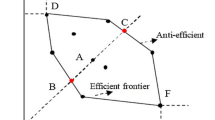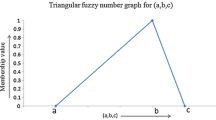Abstract
Data envelopment analysis (DEA) method has been widely used in many economic and industrial applications to measure efficiency and rank performances of decision making units (DMUs). Improving the accuracy and computation time in measuring the efficiency of DMUs have been two main challenges for the DEA. Specifically, with large DMUs, the DEA-based methods are argued to require large amount of memory space and CPU time to measure DMUs efficiencies, and suffer from inability to obtain complete performance ranking. To address these issues, in this paper, a new alternative method that is based on input oriented model (IOM) and efficiency ratio (ER), called ratio efficiency dominance (RED), is proposed. The proposed method seeks to minimize the inputs while maximizing the outputs to obtain efficiency or performance scores, which is independent of DEA method and the use of linear programming (LP). It is also to overcome the drawbacks of uncontrolled convergence, non-generalization and instability induced from integrating prediction techniques such as neural networks (NNs) with DEA. To evaluate the proposed method, experiments were performed on small, large and very large DMUs data sets to show the effectiveness of proposed method. The experimental results demonstrated that, in all cases, the proposed method is able to produce a complete and more accurate ranking compared to the conventional DEA methods or its hybrids.







Similar content being viewed by others
References
Abe S (2010) Support vector machines for pattern classification. Springer, New York
Adler N, Golany B (2001) Evaluation of deregulated airline networks using data envelopment analysis combined with principal component analysis with an application to Western Europe. Eur J Oper Res 132(2):260–273
Apice A, Ceci M, Malerba D (2003) Mining model trees: a multi-relational approach. In: Inductive Logic Programming. Springer, Berlin, Heidelberg, pp 4–21
Ali AI (1990) Data envelopment analysis: computational issues. Comput Environ Urban Syst 14(2):157–165
Ali AI (1993) Streamlined computation for data envelopment analysis. Eur J Oper Res 64(1):61–67
Ali AI (1994) Computational aspects of DEA. Springer, The Netherlands
Ali AI, Seiford LM (1993) Computational accuracy and infinitesimals in data envelopment analysis. Infor 31(4):290–297
Andersen P, Petersen NC (1993) A procedure for ranking efficient units in data envelopment analysis. Manag Sci 39(10):1261–1264
Banker RD, Charnes A, Cooper WW (1984) Some models for estimating technical and scale inefficiencies in data envelopment analysis. Manag Sci 30(9):1078–1092
Barr RS, Durchholz ML (1997) Parallel and hierarchical decomposition approaches for solving large-scale data envelopment analysis models. Ann Oper Res 73:339–372
Barr RS, Killgo KA, Siems TF, Zimmel S (2002) Evaluating the productive efficiency and performance of US commercial banks. Manag Finance 28(8):3–25
Çelebi D, Bayraktar D (2008) An integrated neural network and data envelopment analysis for supplier evaluation under incomplete information. Expert Syst Appl 35(4):1698–1710
Chang CC, Lin CJ (2011) LIBSVM: a library for support vector machines. ACM Trans Intell Syst Technol 2(3):27
Charnes A, Cooper WW, Rhodes E (1978) Measuring the efficiency of decision making units. Eur J Oper Res 2(6):429–444
Charnes A, Cooper WW, Golany B, Seiford L, Stutz J (1985) Foundations of data envelopment analysis for Pareto-Koopmans efficient empirical production functions. J Econom 30(1):91–107
Chen CM, van Dalen J (2010) Measuring dynamic efficiency: theories and an integrated methodology. Eur J Oper Res 203(3):749–760
Chen JX, Deng M (2011) A cross-dependence based ranking system for efficient and inefficient units in DEA. Expert Syst Appl 38(8):9648–9655
Chen JX, Deng M, Gingras S (2011) A modified super-efficiency measure based on simultaneous input–output projection in data envelopment analysis. Comput Oper Res 38(2):496–504
Chen Y, Sherman HD (2004) The benefits of non-radial vs. radial super-efficiency DEA: an application to burden-sharing amongst NATO member nations. Soc Econ Plan Sci 38(4):307–320
Chen Y, Du J, Huo J (2013) Super-efficiency based on a modified directional distance function. Omega 41(3):621–625
Cooper WW, Seiford LM, Tone K (2007) Data envelopment analysis: a comprehensive text with models, applications, references and DEA-Solver Software, 2nd edn. Springer, New York, p 490 ISBN 387452818
Cooper WW, Seiford LM, Zhu J (2011) Handbook on data envelopment analysis, vol 164. Springer, New York
Cortes C, Vapnik V (1995) Support-vector networks. Mach Learn 20(3):273–297
Cristianini N, Shawe-Taylor J (2000) An introduction to support vector machines and other kernel-based learning methods. Cambridge University Press, Cambridge
Debreu G (1951) The coefficient of resource utilization. Econometrica:273–292
Doyle J, Green R (1994) Efficiency and cross-efficiency in DEA: derivations, meanings and uses. J Oper Res Soc:567-578
Dula JH (2008) A computational study of DEA with massive data sets. Comput Oper Res 35(4):1191–1203
Emrouznejad A, Shale E (2009) A combined neural network and DEA for measuring efficiency of large scale data sets. Comput Ind Eng 56(1):249–254
Farahmand M, Desa MI, Nilashi M (2014) Hybrid data envelopment analysis and neural networks for suppliers efficiency prediction and ranking. Int Conf Recent Trends Inf Commun Technol:392–401
Farahmand M, Desa MI, Nilashi M (2014b) A combined data envelopment analysis and support vector regression for efficiency evaluation of large decision making units. Int J Eng Technol:2310–2321
Farahmand M, Desa MI, Nilashi M, Wibowo A (2014c) An improved method for predicting and ranking suppliers efficiency using data envelopment analysis. J Teknol 73(2)
Farahmand M, Desa MI, Nilashi M (2015) A comparative study of CCR-(\(\varepsilon \)-SVR) and CCR-(\(\nu \)-SVR) models for efficiency prediction of large decision making units. J Soft Comput Decis Support Syst 2(1):8–17
Färe R, Knox Lovell CA (1978) Measuring the technical efficiency of production. J Econ Theory 19(1):150–162
Farrell MJ (1957) The measurement of productive efficiency. J Royal Stat Soc Ser A:253-290
Guo D, Wu J (2013) A complete ranking of DMUs with undesirable outputs using restrictions in DEA models. Math Comput Model 58(5):1102–1109
Guosheng H, Guohong Z (2008) Comparison on neural networks and support vector machines in suppliers’ selection. Syst Eng Electron J 19(2):316–320
Ho W, Xu X, Dey PK (2010) Multi-criteria decision making approaches for supplier evaluation and selection: A literature review. Eur J Oper Res 202(1):16–24
Hosseinzadeh Lotfi F, Jahanshahloo GR, Khodabakhshi M, Rostamy-Malkhlifeh M, Moghaddas Z, Vaez-Ghasemi M (2013) A review of ranking models in data envelopment analysis. J Appl Math
Hosseinzadeh Lotfi F, Noora AA, Jahanshahloo GR, Reshadi M (2011) One DEA ranking method based on applying aggregate units. Expert Syst Appl 38(10):13468–13471
Jahanshahloo GR, Hosseinzadeh Lotfi F, Zhiani Rezai H, Rezai Balf F (2007) Finding strong defining hyperplanes of production possibility set. Eur J Oper Res 177(1):42–54
Jahanshahloo GR, Memariani A, Lotfi FH, Rezai HZ (2005) A note on some of DEA models and finding efficiency and complete ranking using common set of weights. Appl Math Comput 166(2):265–281
Jahanshahloo GR, Pourkarimi L, Zarepisheh M (2006) Modified MAJ model for ranking decision making units in data envelopment analysis. Appl Math Comput 174(2):1054–1059
Jiang B, Chen W, Zhang H, Pan W (2013) Supplier’s efficiency and performance evaluation using DEA-SVM approach. J Softw 8(1):25–30
Kao C (2010) Malmquist productivity index based on common-weights DEA: the case of Taiwan forests after reorganization. Omega 38(6):484–491
Khezrimotlagh D, Salleh S, Mohsenpour Z (2013) A new method for evaluating decision making units in DEA. J Oper Res Soc 65(5):694–707
Kontis AP, Vrysagotis V (2011) Supplier selection problem: a literature review of multi-criteria approaches based on DEA. Adv Manag Appl Econ 1(2):207–219
Koopmans TC (1951) Analysis of production as an efficient combination of activities. Act Anal Prod Alloc 13:33–37
Li S, Jahanshahloo GR, Khodabakhshi M (2007) A super-efficiency model for ranking efficient units in data envelopment analysis. Appl Math Comput 184(2):638–648
Liu FHF, Hsuan Peng H (2008) Ranking of units on the DEA frontier with common weights. Comput Oper Res 35(5):1624–1637
Lu WM, Lo SF (2009) An interactive benchmark model ranking performers–application to financial holding companies. Math Comput Model 49(1):172–179
Mehrabian S, Alirezaee MR, Jahanshahloo GR (1999) A complete efficiency ranking of decision making units in data envelopment analysis. Comput Optim Appl 14(2):261–266
Mo Y (2014) Applications of SVR to the Aveiro discretization method. Soft Comput:1–13
Nadimi R, Shakouri H (2011) Factor Analysis (FA) as ranking and an efficient data reducing approach for decision making units: SAFA rolling & Pipe Mills Company Case Study. Appl Math Sci 5(79):3917–3927
Narasimhan R, Talluri S, Mendez D (2001) Supplier evaluation and rationalization via data envelopment analysis: an empirical examination. J Supply Chain Manag 37(2):28–37
Nilashi M, Ibrahim OB, Ithnin N, Zakaria R (2014) A multi-criteria recommendation system using dimensionality reduction and neuro-fuzzy techniques. Soft Comput:1–35
Ozdemir D, Temur GT (2009) DEA ANN approach in supplier evaluation system. World Acad Sci Eng Technol 54(538):343–348
Paradi JC, Zhu H, Edelstein B (2012) Identifying managerial groups in a large Canadian bank branch network with a DEA approach. Eur J Oper Res 219(1):178–187
Pastor JT, Ruiz JL, Sirvent I (1999) An enhanced DEA Russell graph efficiency measure. Eur J Oper Res 115(3):596–607
Podinovski VV (2001) DEA models for the explicit maximization of relative efficiency. J Oper Res Soc 131(3):572–586
Podinovski VV (2005) The explicit role of weight bounds in models of data envelopment analysis. J Oper Res Soc 56(12):1408–1418
Ramón N, Ruiz JL, Sirvent I (2012) Common sets of weights as summaries of DEA profiles of weights: with an application to the ranking of professional tennis players. Expert Syst Appl 39(5):4882–4889
Salo A, Punkka A (2011) Ranking intervals and dominance relations for ratio-based efficiency analysis. Manage Sci 57(1):200–214
Samoilenko S, Osei-Bryson KM (2010) Determining sources of relative inefficiency in heterogeneous samples: methodology using cluster analysis, dea and neural networks. Eur J Oper Res 206(2):479–487
Sexton TR (1986) The methodology of data envelopment analysis. New Dir Prog Eval 1986(32):7–29
Soltanifar M, Hosseinzadeh Lotfi F (2011) The voting analytic hierarchy process method for discriminating among efficient decision making units in data envelopment analysis. Comput Ind Eng 60(4):585–592
Soltanifar M, Shahghobadi S (2014) Survey on rank preservation and rank reversal in data envelopment analysis. Knowl Based Syst 60:10–19
Sueyoshi T (1999) DEA non-parametric ranking test and index measurement: slack-adjusted DEA and an application to Japanese agriculture cooperatives. Omega 27(3):315–326
Tone K (2001) A slacks-based measure of efficiency in data envelopment analysis. Eur J Oper Res 130(3):498–509
Torgersen AM, Førsund FR, Kittelsen SA (1996) Slack-adjusted efficiency measures and ranking of efficient units. J Prod Anal 7(4):379–398
Vapnik V (1995) The nature of statistical learning theory. Springer, New York
Wang YM, Luo Y, Liang L (2009) Ranking decision making units by imposing a minimum weight restriction in the data envelopment analysis. J Comput Appl Math 223(1):469–484
Wen M, Qin Z, Kang R, Yang Y (2014) Sensitivity and stability analysis of the additive model in uncertain data envelopment analysis. Soft Comput:1–10
Wu D (2009) Supplier selection: a hybrid model using DEA, decision tree and neural network. Expert Syst Appl 36(5):9105–9112
Zerafat Angiz M, Mustafa A, Kamali MJ (2013) Cross-ranking of decision making units in data envelopment analysis. Appl Math Model 37(1):398–405
Zhu J (1998) Data envelopment analysis vs. principal component analysis: an illustrative study of economic performance of Chinese cities. Eur J Oper Res 111(1):50–61
Author information
Authors and Affiliations
Corresponding author
Ethics declarations
Conflict of interest
The authors declare that they have no conflict of interest.
Additional information
Communicated by V. Loia.
Rights and permissions
About this article
Cite this article
Farahmand, M., Desa, M.I. RED: a new method for performance ranking of large decision making units. Soft Comput 21, 1271–1290 (2017). https://doi.org/10.1007/s00500-015-1860-9
Published:
Issue Date:
DOI: https://doi.org/10.1007/s00500-015-1860-9




